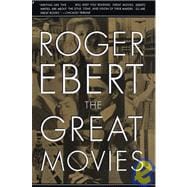
Note: Supplemental materials are not guaranteed with Rental or Used book purchases.
Purchase Benefits
What is included with this book?
| Introduction | p. xv |
| Still and Moving | p. xxi |
| 2001: A Space Odyssey | p. 1 |
| The 400 Blows | p. 7 |
| 8 1/2 | p. 12 |
| Aguirre, the Wrath of God | p. 17 |
| Ali: Fear Eats the Soul | p. 22 |
| All About Eve | p. 27 |
| The Apartment | p. 32 |
| Apocalypse Now | p. 37 |
| The Apu Trilogy | p. 43 |
| Battleship Potemkin | p. 48 |
| Beauty and the Beast | p. 53 |
| Belle de Jour | p. 58 |
| The Bicycle Thief | p. 63 |
| The Big Sleep | p. 68 |
| Blowup | p. 74 |
| Body Heat | p. 79 |
| Bonnie and Clyde | p. 84 |
| Bride of Frankenstein | p. 89 |
| Broken Blossoms | p. 94 |
| Casablanca | p. 99 |
| Chinatown | p. 104 |
| Citizen Kane | p. 109 |
| City Lights | p. 118 |
| Days of Heaven | p. 123 |
| The Decalogue | p. 128 |
| Detour | p. 133 |
| Do the Right Thing | p. 138 |
| Double Indemnity | p. 143 |
| Dracula | p. 148 |
| Dr. Strangelove | p. 154 |
| Duck Soup | p. 159 |
| E.T. | p. 164 |
| The Exterminating Angel | p. 169 |
| Fargo | p. 174 |
| Floating Weeds | p. 179 |
| Gates of Heaven | p. 184 |
| The General | p. 189 |
| The Godfather | p. 194 |
| Gone with the Wind | p. 199 |
| Grand Illusion | p. 204 |
| Greed | p. 209 |
| A Hard Day's Night | p. 214 |
| Hoop Dreams | p. 219 |
| Ikiru | p. 224 |
| It's a Wonderful Life | p. 229 |
| JFK | p. 234 |
| La Dolce Vita | p. 239 |
| The Lady Eve | p. 244 |
| Last Year at Marienbad | p. 249 |
| L'Atalante | p. 254 |
| L'Avventura | p. 259 |
| Lawrence of Arabia | p. 264 |
| Le Samourai | p. 269 |
| M | p. 274 |
| The Maltese Falcon | p. 279 |
| Manhattan | p. 284 |
| McCabe & Mrs. Miller | p. 289 |
| Metropolis | p. 294 |
| Mr. Hulot's Holiday | p. 299 |
| My Darling Clementine | p. 304 |
| My Life to Live | p. 309 |
| Nashville | p. 314 |
| Network | p. 319 |
| The Night of the Hunter | p. 324 |
| Nosferatu | p. 329 |
| Notorious | p. 334 |
| On the Waterfront | p. 339 |
| Pandora's Box | p. 344 |
| The Passion of Joan of Arc | p. 349 |
| Peeping Tom | p. 354 |
| Persona | p. 359 |
| Pickpocket | p. 364 |
| Pinocchio | p. 369 |
| Psycho | p. 374 |
| Pulp Fiction | p. 380 |
| Raging Bull | p. 385 |
| Red River | p. 390 |
| Schindler's List | p. 395 |
| The Seven Samurai | p. 400 |
| The Seventh Seal | p. 405 |
| The Shawshank Redemption | p. 410 |
| The Silence of the Lambs | p. 415 |
| Singin' in the Rain | p. 420 |
| Some Like It Hot | p. 425 |
| Star Wars | p. 430 |
| Sunset Blvd | p. 436 |
| Sweet Smell of Success | p. 441 |
| Swing Time | p. 446 |
| Taxi Driver | p. 451 |
| The Third Man | p. 456 |
| Trouble in Paradise | p. 461 |
| Un Chien Andalou | p. 466 |
| The "Up" Documentaries | p. 471 |
| Vertigo | p. 477 |
| The Wild Bunch | p. 482 |
| Wings of Desire | p. 487 |
| The Wizard of Oz | p. 492 |
| Woman in the Dunes | p. 497 |
| A Woman Under the Influence | p. 502 |
| Written on the Wind | p. 507 |
| Table of Contents provided by Ingram. All Rights Reserved. |
The New copy of this book will include any supplemental materials advertised. Please check the title of the book to determine if it should include any access cards, study guides, lab manuals, CDs, etc.
The Used, Rental and eBook copies of this book are not guaranteed to include any supplemental materials. Typically, only the book itself is included. This is true even if the title states it includes any access cards, study guides, lab manuals, CDs, etc.
Excerpted from The Great Movies by Roger Ebert
All rights reserved by the original copyright owners. Excerpts are provided for display purposes only and may not be reproduced, reprinted or distributed without the written permission of the publisher.